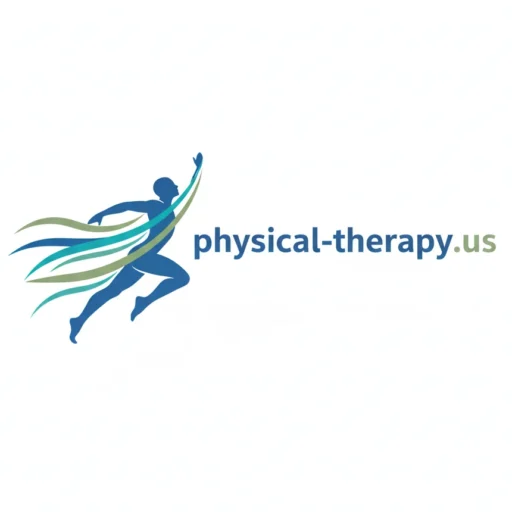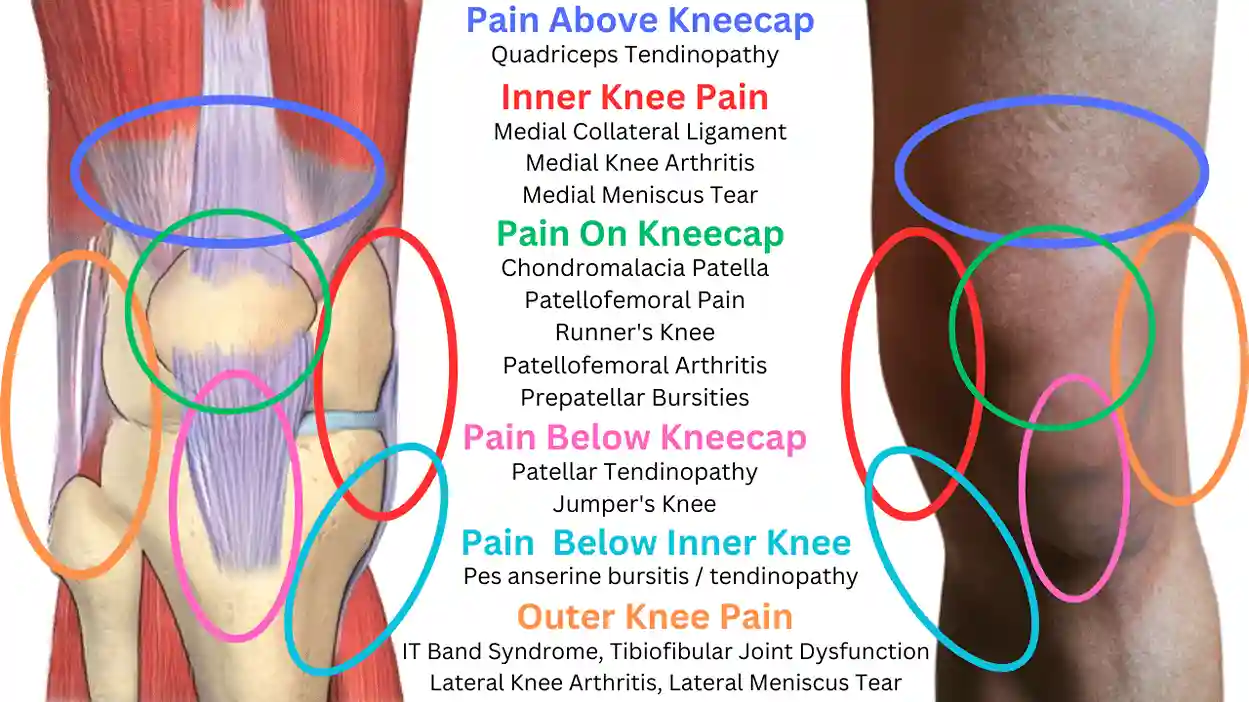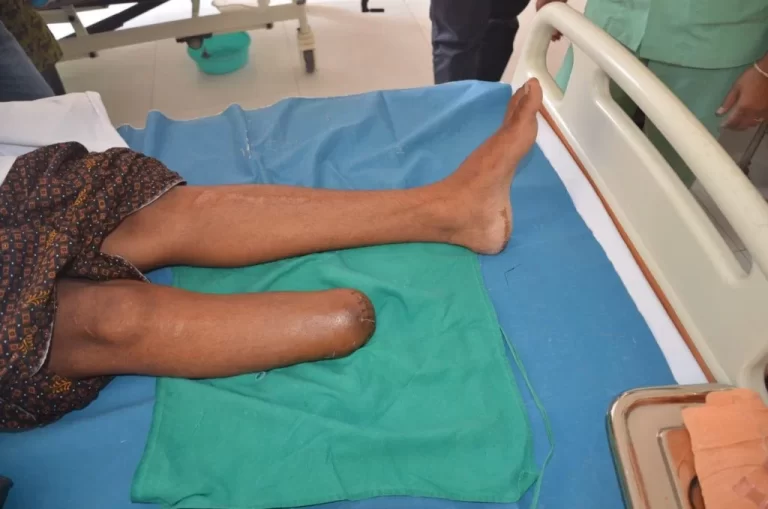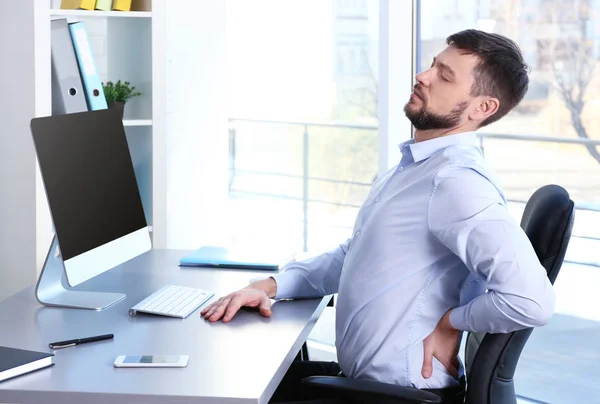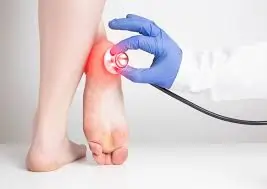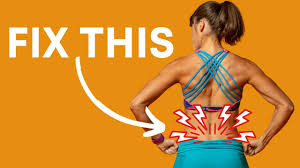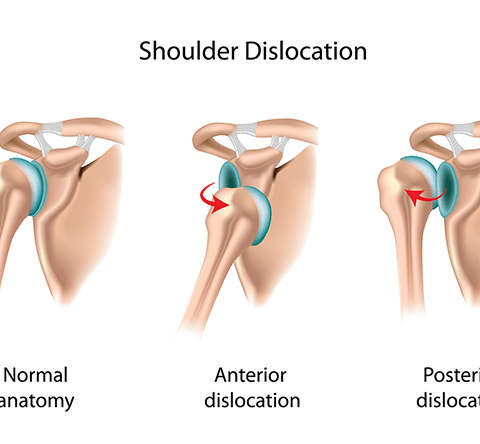Knee Pain Location Chart
Introduction
Knee pain can range in intensity from a little annoyance or cause of concern to a serious issue that affects your mobility and way of life. It is unique, though, in that it possesses some rotational movement in addition to being the largest hinge joint in the body.
People of various ages and activity levels may experience knee pain, which can be a chronic problem. Navigating the intricacy of knee pain requires an understanding of the multiple locations where pain may arise. We’ll look at the various knee pain points and the possible injuries that go along with them in this article.
Pain at the front above the knee
 Pain-at-the-front-above-the-knee
Pain-at-the-front-above-the-knee
Possible Causes of Pain
Quadriceps tendonitis
This results from the quadriceps tendon being irritated, strained, or injured. Basketball and volleyball players are among the athletes who frequently suffer from quadriceps tendinitis. A sudden increase in physical activity increases the danger.
Patellofemoral Arthritis
The patella, the bottom of the kneecap, and the trochlear groove in the femur, where it travels, are all impacted. Pain results from the bones coming into contact with one another when the articular cartilage that covers their surfaces deteriorates and becomes inflamed.
These folds were initially seen in the knee joint in four different locations; however, they frequently disappear during fetal development. Trauma, twisting, or repetitive knee movement can all result in an inflamed plica, which causes knee pain and weakness. An inflamed plica, which results from trauma, twisting, or repetitive knee movement, can cause knee pain and paralysis.
Lateral patellar facet overload syndrome
Inappropriate tracking, inadequate alignment, or kneecap displacement are the primary causes of this condition. When performing repetitive exercises like climbing stairs, the condition is frequently noticeable.
Synovitis
The knee is covered by a synovial membrane since it is a synovial hinge joint. This membrane’s inflammation is known as synovitis. It causes recurrent bleeding into the joint and is caused by trauma or overuse. The synovial membrane thickens with the addition of new blood vessels and becomes swollen and painful if treatment is delayed or improper. Gout and arthritis are also linked to it.
Furthermore, arthritis can cause inflammation, stiffness, and joint structural degradation, which can either cause or worsen these problems. To address the underlying problems and reduce pain, a proper diagnosis and course of therapy are necessary, enabling people to keep their mobility and partake in their favorite activities.
Pain at the knee itself
 Pain at the knee itself
Pain at the knee itself
Both frontal and internal knee pain are included in this.
Possible Causes of Pain
Anterior Cruciate Ligament (ACL)
Running through the knee, the ACL provides support and regulates movement in both directions. Twisting, overextension, or sudden force through the knee can cause damage. Pain, a potential “popping” sound, swelling, and instability are some of the symptoms.
Patellofemoral pain syndrome
A variety of explanations can lead to PFPS. Overuse from intensive sports or training, as well as problems with kneecap alignment, are often major causes. Runner’s knee is another name for it. Several reasons, including excessive use or kneecap displacement. Because of the pain and stiffness caused by PFPS, it may be challenging to kneel, climb stairs, and carry out other daily tasks.
Chondromalacia patella
When the cartilage beneath the kneecap softens and breaks down, chondromalacia patella can result in pain and grinding sensations when the knee moves, causing pain and problems at the thigh-kneecap junction. This disease, commonly known as “runner’s knee,” is typified by anterior knee pain, especially when bending or kneeling. It is caused by either a loose cartilage flap or the softening and degeneration of the kneecap’s underlying cartilage.
Patellofemoral Arthritis
The groove on the bottom of the thigh bone should allow the kneecap to glide freely. Failure to do so may result in the cartilage of the two surfaces deteriorating and the bones rubbing against each other, which would cause arthritic pain.
Partially dislocated patella
The kneecap (patella) moves out of its natural groove in the knee joint but does not fully dislocate, resulting in a partially dislocated patella, commonly referred to as a patellar subluxation. Instability, pain, and a sensation of the kneecap shifting out of position might result from this.
Patella tendonitis
This is frequently the result of repeated running or leaping. Inflammation and pain may result from the tendon’s microscopic tears caused by the constant tension. It causes a burning feeling directly beneath the kneecap.
Most prevalent among kids or teenagers. However, the problem may also affect less active teens. It causes edema as well as a tight, sensitive sensation.
Sinding-Larsen-Johansson syndrome
Active teenagers are often impacted by this. In young people with Sinding-Larsen-Johansson (SLJ) syndrome, the patella, the bottom of the kneecap, becomes tender and painful. It is caused by irritation of the patellar tendon at the point where it attaches to the kneecap, typically as a result of repeated microtrauma, particularly during growth spurts.
Bursitis
The tiny, fluid-filled sacs known as bursae are found where soft tissue and bone meet. Around the affected joint, this inflammation may result in pain, swelling, and tenderness.
Osteoarthritis
Initially, the symptoms could be minor, but ultimately, surgery might be required. The joint’s articular (or hyaline) cartilage declines and stops supporting the bones. Additionally, the cartilage is no longer lubricated and maintained by synovial fluid. Pain and stiffness are the end effects, and they get worse with time.
Bone tumours
When bone cells (osteoblasts, osteocytes, and osteoclasts) divide uncontrollably, they create lumps of tissue that are known as bone tumors. Although the majority of bone tumors are benign, they can weaken the bone and increase its susceptibility to other issues. Some, on the other hand, are malignant and cause metastases, or the spread of diseased cells to other parts of the body. Constant bone pain, localized edema, and inflammation are among the symptoms.
Inflammatory joint disease
The general term “inflammatory joint disease” or “inflammatory arthritis” refers to a variety of illnesses, including several types of arthritis, that are all characterized by inflammation of the joints and frequently other tissues as well. The immune system of the body attacks itself and damages its tissues in many of these autoimmune illnesses.
Lateral pain (outer side of the knee)
 Lateral knee pain
Lateral knee pain
Although there is less chance of problems developing in this location, one of the following conditions could be the cause of any pain that does appear.
Possible Causes of Pain
Hamstring Tendinitis
Inflammation of the tendons in the back of the thigh, where the hamstring muscles connect to the bones, is known as hamstring tendonitis. Overuse or overstretching are frequently the causes. Back thigh soreness, swelling, and tenderness are among the symptoms, which might be made worse by specific activities.
An overuse injury that frequently affects athletes, iliotibial band syndrome (ITBS), has been defined by pain on the outside of the knee. This friction can be caused by underlying issues like muscle imbalances or inadequate training, or it can be caused by repetitive knee movements like those made when running or cycling.
Lateral collateral ligament damage
These injuries frequently happen as a result of direct knee strikes or when participating in sports. Pain, edema, instability, and a popping sound at the site of injury are possible symptoms.
Lateral meniscus tear
The menisci are shaped like strips of cartilage that act as shock absorbers in the knee. The symptoms include a sharp ache that is followed by swelling and trouble walking.
Cyst forming pressure on the meniscus
Synovial fluid can build up and put pressure on the meniscus if there is a tear in the meniscus cartilage. Trauma or excessive knee rotation may be the cause. There can be a bump where the cyst resides, and there might be pain or a burning feeling.
Bony osteophytes may occur, and excess fluid may be created if this cartilage begins to deteriorate and degenerate. A degenerative joint condition in which the cartilage that cushions the ends of bones weakens over time, causing pain, stiffness, and decreased joint mobility. Weight-bearing joints such as the knees, hips, spine, and tiny joints in the hands are usually affected by this most prevalent kind of arthritis.
Just below the knee is the superior (or proximal) tibiofibular joint. It is the point at which the inner and outer sides of the tibia are united. Its function is to promote weight transfer between your foot and your body and to permit and restrict leg twisting. Damage to the peroneal nerve, which is situated at the joint, may result in numbness and a pins-and-needles sensation on the outside of the knee.
Tibial plateau fracture
A tibial plateau fracture is a difficult injury because it happens at the proximal end of the tibia, which is at the top of the shinbone. It impacts the knee through the cartilage on the joint surface where the knee and tibia connect. Additionally, the fracture may impact nearby blood vessels, nerves, and tissue. Pain, swelling, and sometimes numbness or pins and needles are among the symptoms.
Posterolateral corner injury (PLC)
The PLC is the area outside the leg that extends from the top of the tibia and fibula to the bottom of the femur, below the knee. Numerous ligaments and tendons converge at the PLC. They provide support to the knee and prevent overextension. Trauma from sports incidents frequently results in injury to this region. The posterior cruciate ligament is frequently damaged with PLC trauma, and the common peroneal nerve may also be impacted.
Biceps Femoris Tendonitis
This tendon attaches to the outside of the knee and is a component of your hamstring. You may experience pain if it becomes inflamed, particularly when bending or straightening your knee, which frequently occurs during sports like cycling or jogging.
Medial pain (inner side of the knee)
 Medial-Knee-Pain
Medial-Knee-Pain
Injuries to the meniscus, medial collateral ligament (MCL), surrounding tendons, and bursa are some of the possible causes of this pain. Other possible causes include patellofemoral pain syndrome and osteoarthritis.
Possible causes of pain
Irritation of the medial plica
At the embryonic stage, each knee typically has four joints, which facilitate easy joint bending. Knee pain, swelling, or locking may result from an irritated plica caused by an injury or excessive use.
Medial meniscus tear or loose cartilage
Pain, swelling, and issues with mobility will result from a torn meniscus on the inside of the knee or from a little piece of cartilage coming loose or separated (see lateral meniscus tear).
Osteoarthritis
Pain, decreased mobility, and instability result from the creation of excess synovial fluid and the development of bony osteophytes when the cartilage of the medial femorotibial compartment deteriorates and degenerates.
Medial Collateral Ligament damage
An outward (valgus) force acting laterally on the joint is typically the cause of ligament damage, which can manifest as a stretch, partial tear, or rupture. Pain, stiffness, and even bruises are among the symptoms.
Osteochondral defect
Damage and loss of some articular cartilage that impacts the underlying bone is known as an osteochondral defect. Instability, swelling, and soreness when applying weight to the joint are some of the symptoms. Trauma, repeated strain, or a reduction in blood flow are some possible causes.
Avascular necrosis
The bone collapses as a result. Long-term usage of high-dose steroid medicines or excessive alcohol use are among the causes. Progressive pain may initially only be felt when weight is placed on the knee, but it may gradually become constant.
Pain at the back of the knee
 Back of the Knee Pain
Back of the Knee Pain
Knee muscle, tendon, or ligament issues are frequently the cause of pain in this area. Additional potential causes of back-of-the-knee pain could be related to blood vessels or synovial fluid.
Possible Causes of Pain
Hamstring tear or pull
The hamstring muscle may stretch, rip, or tear partially if it is overworked. Frequently caused by intense exertion.
Popliteus muscle injury
The popliteal fossa, a depression at the rear of the knee joint, contains the slender, triangular popliteus muscle. Rotating your leg inwards may cause you to experience tenderness if the muscle is damaged.
Cramp
Any muscle in the back of the leg may experience the well-known, abrupt cramping pain. The muscle tightens and hurts when it contracts uncontrollably. Although some causes are unknown, cramping can be caused by dehydration, muscle tension, or stress. Although cramps are usually benign, they may indicate a more serious issue, like a restricted blood supply.
Posterior cruciate ligament injury
It is located inside the knee and is attached to the femur’s medial condyle and the tibia’s posterior intercondylar region. This ligament typically sustains damage when the knee is bent. Examples of injuries include a partial tear or a major tear, together with additional ligament damage.
Baker’s cyst
A Baker’s cyst is characterized by an excessive amount of synovial fluid in an inflammatory bursa of the popliteal fossa. Between a tendon and bone or between skin and a tendon, bursae are fluid-filled structures that lessen friction between nearby moving parts. Arthritis or trauma can create an increase in synovial fluid, which results in swelling behind the knee and a tight feeling.
Meniscus tear or loose cartilage
The rear of the knee may be stiff and painful due to a torn posterior horn of one of the menisci (see medial and lateral meniscus tears). Athletic activity is frequently the cause of this kind of damage, and the pain might not become apparent right away.
Getting Professional Medical Advice for Knee Health
It can be easier to identify possible sources of pain if you understand the knee pain location chart. Many people suffer from arthritis, which is a relatively prevalent condition that can greatly worsen knee pain. For a precise diagnosis and a suitable course of therapy, it is crucial to speak with a medical expert. A combination of medicine, physical therapy, rest, and, in extreme situations, surgery may be necessary for proper management.
The prevention of knee pain can also be achieved by exercising, keeping a healthy weight, utilizing good form when exercising, and wearing supportive shoes. To promote an active and pain-free lifestyle, keep in mind that your knees are valuable joints that require the right care.
Conclusion
Comprehending the various knee pain points is essential for efficient treatment and recuperation. Regaining ideal knee health requires a focused approach to diagnosis and treatment, regardless of whether the pain is on the front, rear, inner, or outside side of the knee.
You can identify the possible source of your knee pain by pinpointing its exact position. You can determine the reason by observing its location as well as its intensity, type, and other symptoms. The location of the pain in the knee determines its source, which can range from an accident to an infection to an autoimmune condition like arthritis.
Generally speaking, if your knee pain was caused by a violent collision or is producing a lot of swelling or pain around the joint, you should consult a doctor.
FAQs
Why is the back of the knee injured?
Both arthritis and Baker’s cysts can produce pain at the back of the knee. Knee pain is most often caused by osteoarthritis of the joint, bursitis, arthritis, ligament tears, or infection.
What causes pain in the inner knee?
Pain on the inside of your knee can be caused by a variety of problems. These include osteoarthritis, cartilage degeneration, and ligament problems. The most common causes of these diseases include aging, excessive knee use, and sports injuries.
How do you diagnose knee pain?
Determine the location, severity, and type of knee pain (dull or severe), as well as whether it is accompanied by additional symptoms like stiffness, swelling, or popping sounds. If you experience severe cramping, swelling, or trouble carrying your weight, or if your pain lasts more than a few days, consult a physician.
How is arthritis examined?
A doctor would usually conduct a physical examination, order blood tests, and perhaps employ imaging methods like MRIs or X-rays to check for arthritis. In addition to other indications of inflammation, they will search for joint pain, edema, stiffness, and restricted range of motion. Blood testing can be used to find specific antibodies linked to particular forms of arthritis or indicators of inflammation. Imaging can show arthritis-related changes or joint degeneration.
How can a knee ligament injury be identified?
To look for knee ligament injury, doctors use imaging tests and physical examinations. Stress tests such as the Lachman, anterior drawer, and posterior drawer tests are part of physical examinations that measure excessive movement to assess ligament stability. To confirm the damage and rule out additional problems like fractures, imaging procedures such as MRIs and X-rays assist in viewing the ligaments and surrounding tissues.
How can the health of the knee be assessed?
A physical examination and sometimes imaging tests, such as MRIs or X-rays, are performed to examine the alignment, stability, range of motion, and any indications of disease or damage in the knee. In addition to evaluating the strength of the muscles and ligaments, the examination may involve feeling for pain, swelling, and soreness.
Which position is ideal for knee pain?
For people with arthritic knees, the ideal sitting position maintains the knees at a comfortable angle while supporting the back. To improve circulation and lessen pressure, it is advised to place the knees at or slightly below hip level.
How does knee ligament pain feel?
The kind of knee injury you have will be determined by the symptoms you face. If your knee ligament is ripped, you will likely experience knee pain, swelling, and even a giving-way sensation. Additionally, you can hear or feel a crack or snap when your ligament is injured.
How can I lessen my feeling of pain without taking painkillers?
Use ice packs right away after an injury to minimize swelling, whether they are heated or cold. For persistent joint or muscle diseases, heat packs work better. Exercises like walking, stretching, strengthening, or aerobics can help you feel better, stay mobile, and lessen pain.
Reference
- Clark, T. (2019, December 31). Knee Pain Location Chart | The Chelsea Knee Clinic. The Chelsea Knee Clinic. https://www.thechelseakneeclinic.com/blog/knee-pain-location-chart/.
- Kylejohnson. (2025a, February 7). Understanding Knee Pain: A location chart. Arthritis Knee Pain Centers. https://arthritiskneepain.com/wellness-blog/knee-pain-location-chart/.
- Haziq. (2024, May 20). Knee Pain Location Chart | Town Center Orthopaedics. Town Center Orthopaedics. https://www.towncenterortho.com/blog/knee-pain-location-chart/.
- Eustice, C. (2023, July 11). Knee pain location chart and possible causes. Verywell Health. https://www.verywellhealth.com/sources-of-knee-pain-normal-joint-diagram-189258
